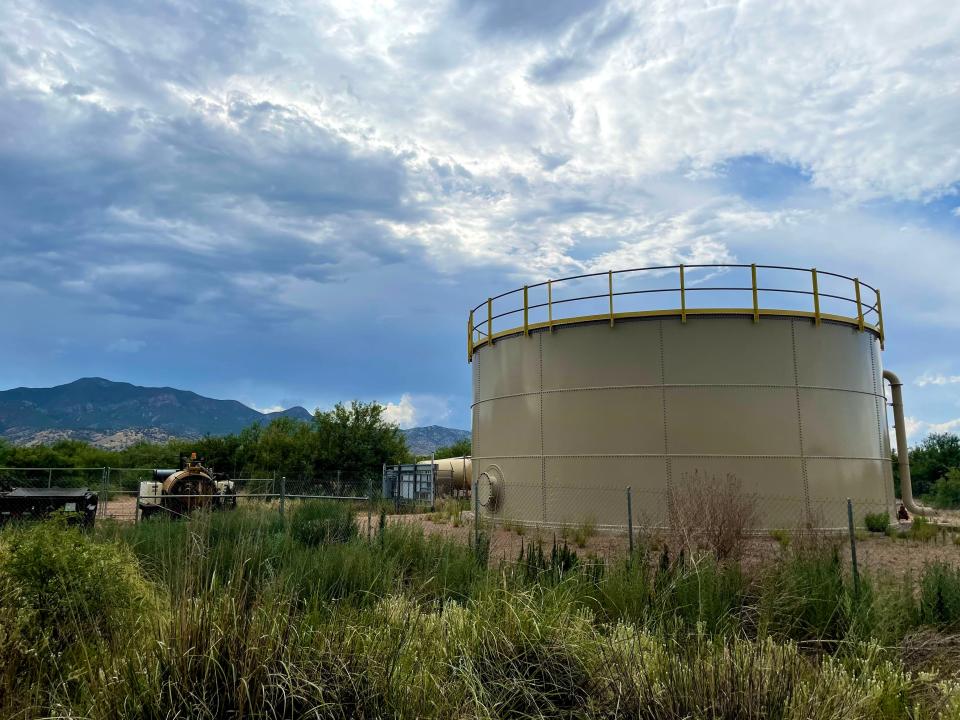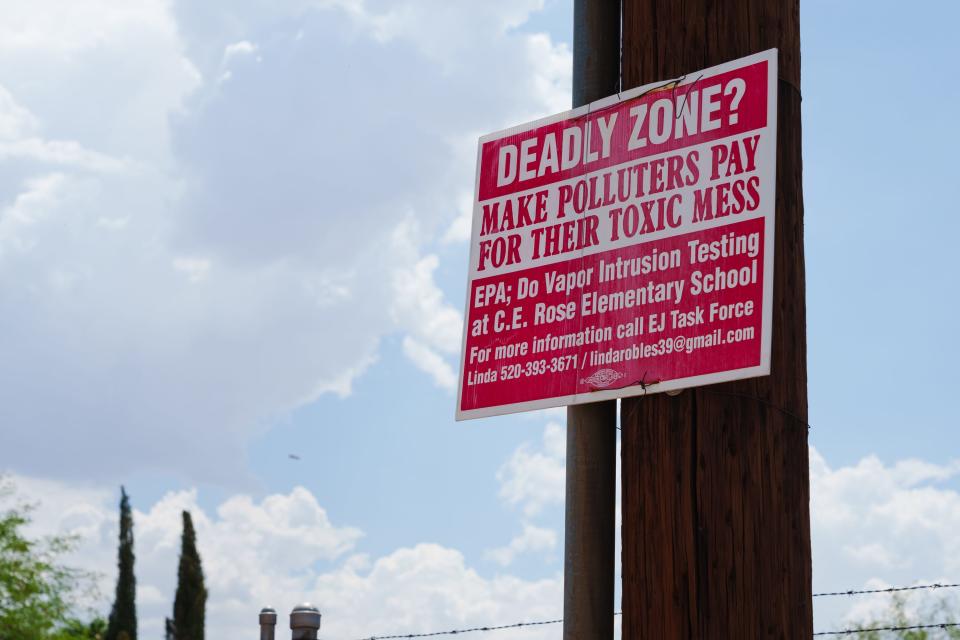Are PFAS really 'forever chemicals'? It's complicated. Here's what to know
- Oops!Something went wrong.Please try again later.
For the past five years, public awareness around PFAS, or "forever chemicals," has been growing in the U.S.
PFAS, short for perfluoroalkyl and polyfluoroalkyl substances, are a large family of chemicals that have been used in a wide variety of products and industries because of their unique stain- and water-repellent properties, as well as heat resistance.
A growing body of evidence has shown that long-term exposure, even to low traces of these chemicals, can cause severe health issues that include cancer, developmental effects and reproductive disorders.
"It's become one of those topics you cannot avoid," said Heather Stapleton, an environmental chemist and exposure scientist in the Nicholas School of the Environment at Duke University.
The chemicals' toxicity was known at least since the 1970s, but regulations in the U.S. to limit their use have been slow.
Early this year, the Environmental Protection Agency proposed and finalized a number of new rules, like requiring risk evaluations for the manufacture, use or processing of about 300 PFAS.
The new rules also establish limits for six kinds of PFAS in drinking water, and set up broader reporting requirements for industries and federal facilities using or disposing of PFAS chemicals. Some states have enacted sweeping bans.
Scientific research around PFAS, and funding for it, has also grown in the last decade, which has led to a deeper understanding of the distribution, pathways of exposure, effects and treatment alternatives for this family of chemicals.
The Arizona Republic talked to exposure scientists and environmental chemists to explore what you need to know about PFAS.
Not all PFAS are 'forever' chemicals
One common mistake is the overarching use of “forever chemicals” to label PFAS, said Stapleton.
Some PFAS can last incredibly long in the environment. They "bioaccumulate," meaning that we store them in our bodies faster than we can get rid of them, and their concentration increases over time.
Chemicals like PFOS, PFOA and PFHxS are "for all intents and purposes correctly labeled as forever chemicals," said Christopher Higgins, a leading U.S. expert on PFAS and a distinguished professor at the Colorado School of Mines.
"We really don't expect them to break down under any meaningful timescales."
These are perfluorinated compounds. Other PFAS break down easily and transform.
Broadly speaking, all PFAS have a chain of carbon atoms bonded to fluorine atoms. Some substances have every carbon-hydrogen bond replaced by a fluorine atom (per-fluorinated) others have only some carbon-fluorine bonds (poly-fluorinated).
It's like a crack in the molecule's armor, Higgins said.
That molecule has the potential to degrade under environmental conditions. And many polyfluoroalkyl substances do transform in the environment.
The reason why both are grouped together is because those more unstable PFAS can form perfluoroalkyl acids, he added.
They are considered precursors to the "forever" chemicals.

One kind of PFAS in firefighters' gear, called fluorotelomer alcohols, does break down in the environment. They are precursors to PFOA and other substances.
Scientists are working to understand what these PFAS are breaking down into and the consequences of it, Stapleton said.
Chemicals can break down into a number of different things, for better or worse. They could be more or less toxic. The result can be different if they break down by bacteria, oxygen or heat.
PFAS danger: Firefighters face cancer risks from harmful chemicals. Here's how they're working to limit exposure
Soils are a PFAS 'reservoir'

Public and media attention on PFAS contamination has largely centered on water sources, since it's one of the main routes of exposure for the general population.
However, soils generally have higher concentrations of PFAS than bodies of water.
This is true at least for PFOAS and PFOS, two popular "forever" chemicals, according to results of a scientific analysis that looked at nearly 100 reports from across the world measuring the chemicals in soils, surface waters, seawater, and rain.
The main reason is that soils are generally the first point of discharge for PFAS.
At sites like airports, military or firefighting training grounds, crews wash out PFAS-laced firefighting foams, and the chemicals also leach from the tons of waste in landfills.
Even in remote locations, soils can also have some concentration of PFAS because the chemicals can be dispersed by rain, snow and dust.
Soils also retain more of the chemicals and are a "significant reservoir for PFAS," according to results from a study co-authored by University of Arizona researchers Mark Brusseau and Bo Guo, which aggregated data from over 2,500 sites worldwide. This is true, particularly in the vadose zone, the area just above the groundwater table.
Once in the soil, PFAS can be transported into groundwater, plants and animals.
Aquifer recharge, and the rise and fall of groundwater levels, can mobilize the contaminants trapped in the soil, UA researchers found.
But these higher concentrations of PFAS in soil, compared to those in drinking water, are relative.
Comparing the parts per billion of PFAS in the top-inch of soil versus a similar amount of the chemicals in groundwater isn't straightforward because of the difference in volume, Higgins said. There is also the matter of exposure, which is more direct in water than in soil.
Health concerns: PFAS contamination in south Tucson challenges historic cleanup
Your lettuce is safe, most likely
PFAS in contaminated soil and irrigation water can end up in food.
The European Union and countries like Australia and New Zealand have already evaluated and established "tolerable daily intakes" for a number of the chemicals. The U.S. has no regulations that suggest a safety threshold for PFAS in food.
Advisories tend to focus on products like fish, eggs, shrimp, and meat. Some of the most widely studied PFAS, and those of greater health concern, are more likely to pass down the food chain and accumulate in protein-rich food.
Scientists like Higgins are trying to relate how much of PFAS contaminants in soil make it into vegetables, and how much of that we actually ingest.
The good news is that the kind of PFAS with the highest health concerns are less likely to be taken up by plants. Plants take PFAS from the ground but they are more likely to be PFAS with a shorter chain of atoms, which have higher advisory limits, he added.
Although there is some concentration of PFAS in soils, it's only in places with very high levels of contamination that consumers could be "justifiably concerned about lettuce or kale," he said.
Advances, and commercial ventures, in PFAS blood testing
Blood test results can now be obtained with the prick of a finger — and a cost.
Eurofins EnvironeX, a company that leads much of the PFAS testing for public water systems in Arizona, recently helped develop and support research on at-home PFAS blood testing technology.
Most measurements of PFAS in humans are made with serum, a fluid derived from blood but without coagulants or red blood cells, which requires the presence of a medical professional, said Stapleton. The new kit, mailed to users, tests whole blood.
"We wanted to validate that these measurements were accurate and meaningful and understand how you can compare a measurement in whole blood to a measurement in serum," she added. Both she and Higgins were part of the research team.
Researchers compared patients' PFAS test results using both approaches. They were highly correlated for almost all PFAS. One chemical was detected in blood tests but not serum, she said.
The new kit could increase diagnoses accessibility, costs aside. Results can be very accurate and the kits can reach people who would have a harder time getting to a specific clinic, Stapleton said.
"I think that the bigger obstacle here is that most physicians are not aware of PFAS because they're not introduced to this topic during their medical school training," Stapleton said.
"I think there are also obstacles for our physicians in trying to understand the scope of this problem and how they can best help their patients."
Resources like pfas-exchange.org and guidelines from the National Academies of Sciences, Engineering, and Medicine are a great starting point, she said.
PFAS monitoring: EPA introduces new national standards for 'forever chemicals' in drinking water
There is a leap in treatment and destruction of PFAS in water

Reverse osmosis and granular activated carbon filters are well-known technologies to remove PFAS from water, but they are not the only things available. Other lesser-known treatments using ion-exchange resins and "foam fractionation" are also used for treatment.
"You take a contaminated water and you bubble lots of air through it. These things (PFAS) are surfactants, just like soap, and they form a big foam on the top of the water tank, and you skim that off and you're treating the water by removing that foam," Higgins said about fractionation.
In Arizona, researchers are also developing new treatment approaches by teaming with microbes.
Bruce Rittmann director of ASU's Biodesign Swette Center for Environmental Biotechnology, patented in 2015 the "membrane biofilm reactor" system, a technology that helps remove contaminants from water using naturally occurring microorganisms. A modification of this technology now helps reduce and biodegrade PFAS.
Researchers still need to scale up this research out of the lab.
Water treatment technologies are still expensive and a two-part process. First, PFAS must be separated from the water and concentrated. Second, they need to be destroyed.
"And that's where there's been a lot of progress, a lot of new things," Higgins said. "The concentration technologies are really robust. We've been using those for a while. Destruction technology is not quite as robust."
Currently, there are at least two patents on PFAS destruction technologies, and both involve very high temperatures in water solutions. Higgins is on the patent of one of them.
"One of them is called hydrothermal alkaline treatment. Basically using lime or base to raise the pH. And under high temperature and elevated pressure, these chemicals will break down under those conditions," he said.
That technology, known as HALT, is currently being commercialized and scaled up by Washington-based Aquagga Inc.
The other one is SCOW, which stands for supercritical water oxidation. It also heats water at elevated temperatures and pressure, so much that "water doesn't behave like water anymore and it takes on a what's called a supercritical state," Higgins said. "And under those conditions PFAS also break down."
Looking into indoor exposure and chemical cocktails
Another research frontier when it comes to PFAS is indoor exposure.
For a long time, PFAS have been used at low levels in all kinds of products. Now there is technology and means to detect even the tiniest of concentrations of these compounds.
We know pizza boxes, popcorn bags, dental floss, makeup foundations, eyeglass defoggers, carpets, and leather furniture.
But we don’t know how much is coming from where, and the minimum risk levels for it, Stapleton said.
There are also bigger questions about what PFAS, and a slew of other chemicals, interact with. In indoor dust and air there is “a hodgepodge” of chemicals that individually may not pose great risks but could have adverse health effects acting together, she said.
New studies suggest it’s not a single chemical but a cocktail of them that can be associated with adverse health outcomes, a sum of the parts.
Clara Migoya covers environmental issues for The Arizona Republic and azcentral. Send tips or questions to clara.migoya@arizonarepublic.com.
Environmental coverage on azcentral.com and in The Arizona Republic is supported by a grant from the Nina Mason Pulliam Charitable Trust. Sign up for AZ Climate, our weekly environment newsletter, and follow The Republic environmental reporting team at environment.azcentral.com and @azcenvironment on Facebook, Twitter and Instagram.
You can support environmental journalism in Arizona by subscribing to azcentral.com today.
This article originally appeared on Arizona Republic: Do PFAS really last forever? What you should know about the chemicals

